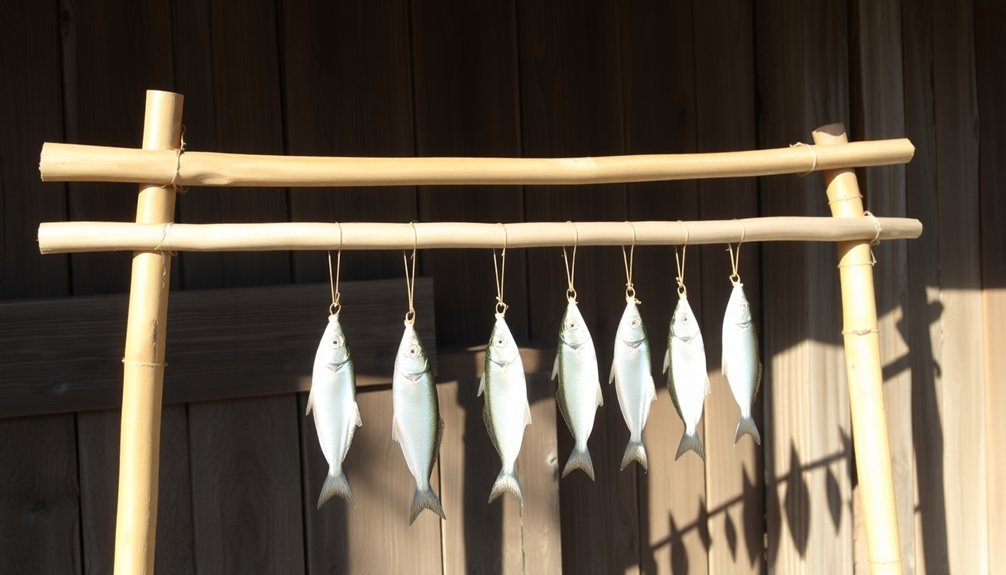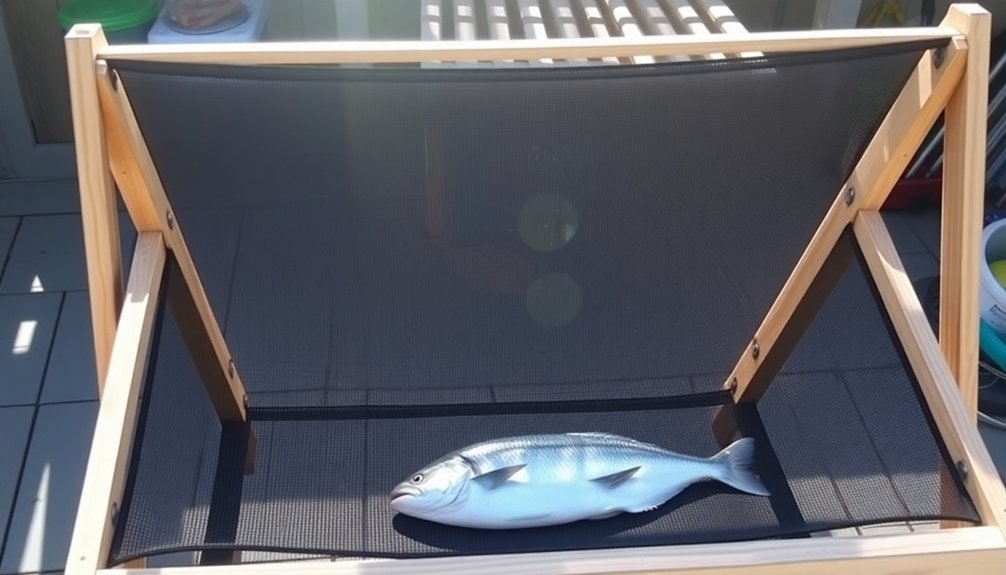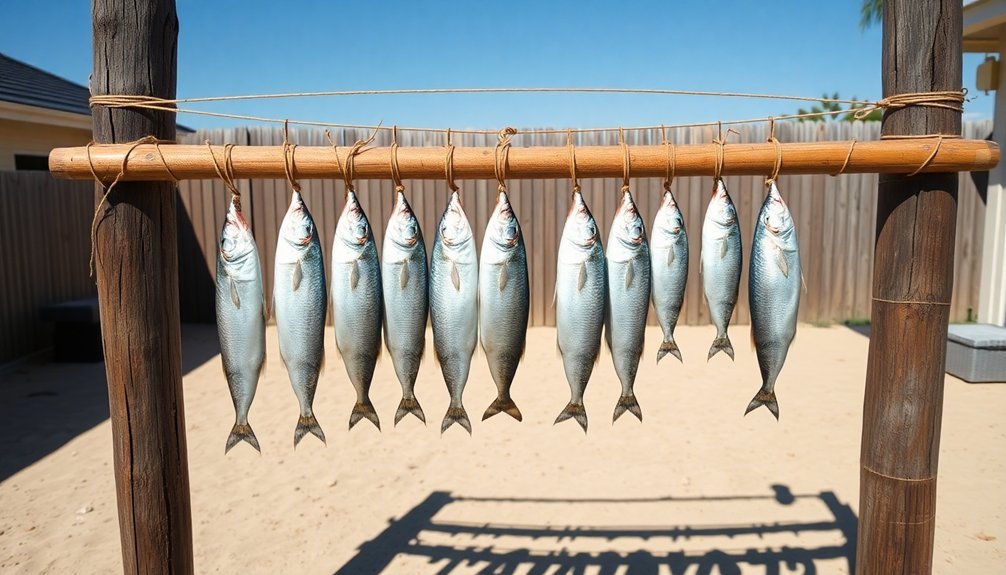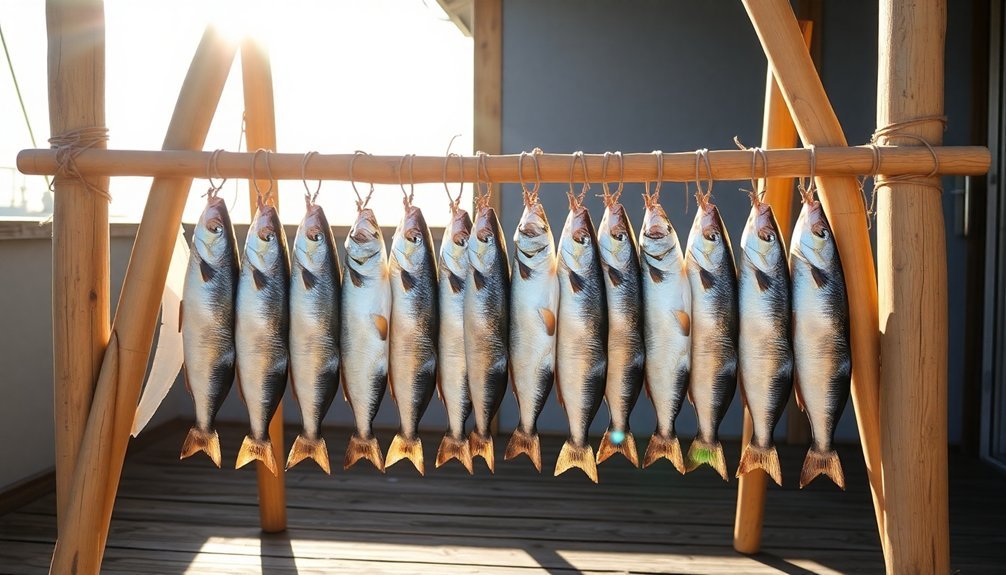You'll find five practical DIY fish drying rack designs that fit any budget and space. The basic bamboo sloping rack offers simplicity and effectiveness, while the portable branch frame lets you relocate as needed. For better protection, try the elevated mesh platform that keeps your catch safe from ground moisture and pests. The hardwood grid system provides durability and excellent air circulation, and the casuarina multipurpose stand offers a cost-effective solution for larger batches. Each design incorporates essential features like rain protection, proper ventilation, and pest control. These time-tested designs will help you master the art of fish preservation.
Basic Bamboo Sloping Rack

Position your rack in an area with good wind exposure and low humidity, keeping it away from trees that might attract insects and animals.
You'll want to guarantee proper air circulation on both sides of the fish to reduce drying time.
When it rains or at night, protect your drying fish with a tarpaulin or waterproof cover.
Remember to maintain the area by regularly clearing any debris from beneath the rack.
Similar to drying fishing lures, consider using screw eyelets for hanging fish at consistent intervals.
Portable Branch Frame Design
While fixed racks serve their purpose well, a portable branch frame design offers greater flexibility for mobile fishing communities.
You'll need locally sourced branches cut to 160cm lengths for the main frame, ensuring they're sturdy enough to support your catch. Bury the main posts 60cm deep for stability, but design them so you can easily remove them when it's time to relocate. Like the steel A-frame structure, this design prioritizes stability while maintaining portability.
Create the frame by fixing lighter branches between the top posts, then add chicken wire or old fishing nets to support your fish.
You'll want to position your rack in an area with good wind exposure and low humidity, keeping it away from trees and waste areas that might attract pests. For effective drying, incorporate a sloping design using a central support pole.
To maintain portability, use simple connections that you can quickly assemble and disassemble. Add hooks or wires to secure your fish, and consider adding a removable waterproof cover for unexpected rain.
Keep the structure clean by regularly sweeping beneath it and checking for worn materials. When selecting branches, choose those with slightly rough surfaces to prevent your fish from sliding off during the drying process.
Elevated Mesh Platform

A sturdy elevated mesh platform offers superior protection and drying efficiency for your fish. You'll want to construct it at least 1 meter above ground using locally available materials like bamboo, wooden timbers, or metallic supports. For the frame, choose hardwood boards that resist heat, fungi, and insects, then attach mesh materials such as chicken wire or old fishing nets. The design allows for efficient moisture removal to significantly extend the shelf life of your fish.
| Feature | Benefit | Implementation |
|---|---|---|
| Sloped Design | Improves drainage | Adjust center/side pole height |
| Elevated Base | Enhances airflow | Build 1m above ground |
| Strategic Placement | Prevents spoilage | Away from trees/waste |
| Protective Cover | Guards against elements | Use tarps/netting |
Position your rack in an exposed area with good air circulation and low humidity. You'll find that raising the platform notably improves air movement compared to ground-level drying. Include a sloping top design to help water drain from fish cavities, and confirm you're maintaining proper balance to prevent the fish from sliding off. For additional protection, cover your rack with plastic sheets during rain and add netting to deter birds and other animals. Regular cleaning underneath the rack will discourage pests and maintain hygiene.
Hardwood Grid System
When setting up your grid, keep it away from trees, rubbish dumps, and processing yards to avoid attracting insects and animals.
You'll want to cover the structure with protective netting to keep out pests, and consider adding a tarp for protection from rain and direct sunlight.
Regular cleaning and maintenance of your grid will prevent contamination and guarantee your fish dry properly.
Casuarina Multipurpose Stand

Building a multipurpose stand using casuarina poles offers a cost-effective alternative to traditional hardwood grids. You'll find these poles readily available in coastal villages, making them an ideal choice for your fish drying needs. To extend their lifespan, coat the lower portions with tar and let them dry thoroughly before installation.
Design your stand at 1½ to 2 feet from the ground to keep animals away, while maintaining a comfortable working height. You can add multiple layers starting at 2½ to 3 feet high, but keep the overall breadth under 4 feet for easy reach. Remember, you'll need about 2 square feet of space for each kilogram of fish you plan to dry.
- You'll feel proud knowing you've built a sustainable drying solution that costs just Rs. 1,000 for a 100kg capacity rack.
- You'll appreciate the improved quality of your dried fish compared to traditional sand-drying methods.
- You'll rest easy knowing your catch is protected from seagulls and ravens.
- You'll enjoy the flexibility of a structure that adapts to your seasonal needs.
Cover your rack with a tarp during rainy weather and guarantee proper spacing between fish to prevent slipping.
Frequently Asked Questions
How Long Does Dried Fish Typically Last When Stored Properly?
When you store dried fish properly, it'll last up to 6 months in your refrigerator and up to 5 years in your freezer. You'll get the best results by using vacuum-sealing methods and airtight containers.
What's the Minimum Distance Needed Between Fish Pieces During Drying?
While there's no strict minimum distance specified, you'll want to leave enough space between fish pieces to allow good air circulation – typically a few inches apart should suffice for effective drying.
Can These Racks Be Used Indoors With Proper Ventilation?
You shouldn't dry fish indoors, even with ventilation. Indoor environments lack adequate air circulation and have higher humidity levels, which can lead to improper drying and potential spoilage of your fish.
How Often Should the Drying Racks Be Cleaned and Sanitized?
You'll need to clean your drying racks after each use and sanitize them weekly. Don't skip daily inspections for debris and mold. Make sure you're thoroughly drying the racks after cleaning to prevent moisture buildup.
What Signs Indicate That Fish Has Been Dried Sufficiently?
You'll know your fish is properly dried when it's firm to touch with no soft spots, has dry non-sticky skin, shows no mold, maintains its shape when handled, and has a mild, dry smell.
In Summary
You'll find these five DIY fish drying rack designs offer practical solutions for preserving your catch. Whether you choose the traditional bamboo slope, portable branch frame, raised mesh platform, sturdy hardwood grid, or versatile casuarina stand, you've got options that fit your space and needs. Don't hesitate to adapt these designs using locally available materials. With basic tools and some effort, you'll be drying fish efficiently in no time.





Leave a Reply